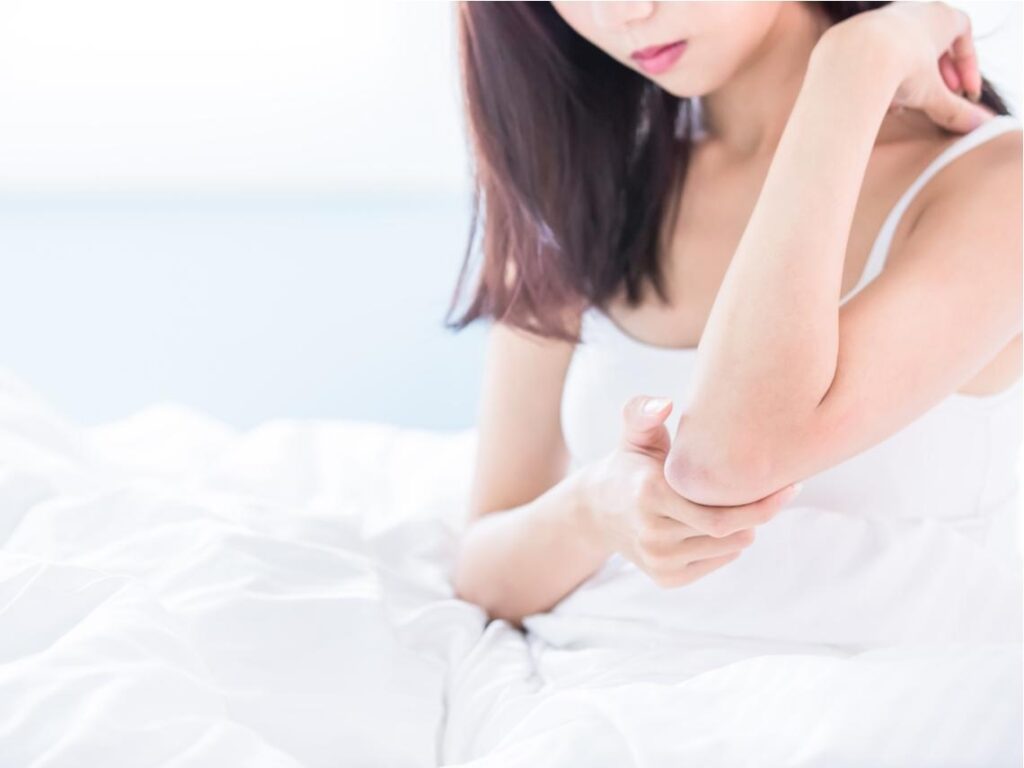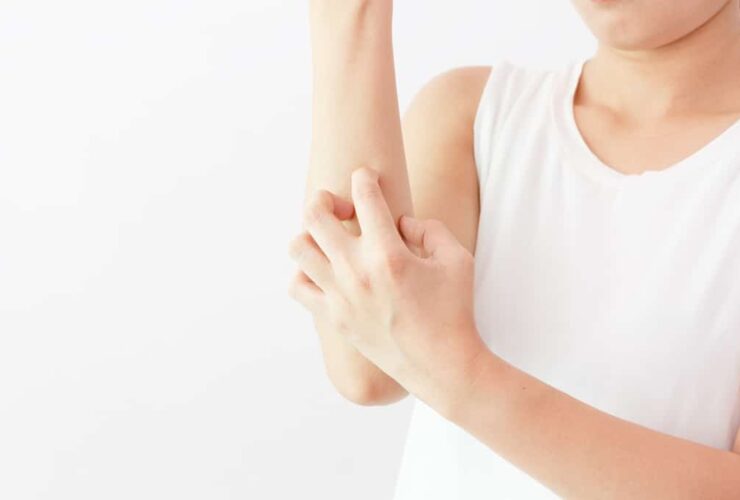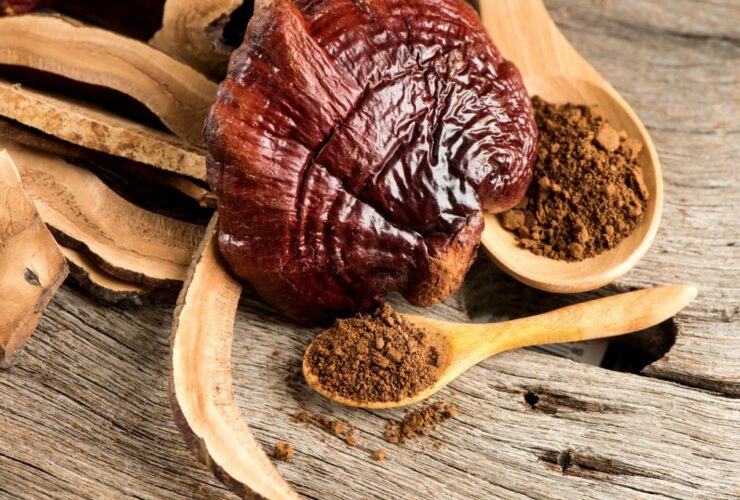
3 Common Types of hives, Recommended Herbal Remedies for hives.

During seasonal transitions, the skin is easily affected by environmental stimuli, leading to symptoms such as redness, itching, and rashes, especially in individuals with sensitive skin. When “skin symptoms” start to appear, it can be worrisome and raise concerns, prompting many to seek dermatological care.
Facing frustrating situations like sudden rashes and itching that interfere with sleep, it indicates that the skin is in a sensitive and fragile state. It is important to pay attention to whether it may be a common skin condition such as hives, eczema, or atopic dermatitis.
This article will introduce you to common types of rashes, their causes, and characteristic symptoms. It will also share daily care methods to help you establish a skincare regimen and break free from the cycle of recurrent rashes, skin redness, and persistent itching.
What are Rashes? Three Common Types of Rashes and Their Causes
“Rashes” are one of the symptoms of skin diseases. They typically manifest as red or white spots on the skin, or can involve redness, swelling, itching, rough skin, and other conditions. The causes of rashes can include allergens from food or the environment, exposure to irritating substances, bug bites, and prolonged fatigue. All of these factors have the potential to trigger rashes.
Now that you understand what “rashes” are, let me introduce you to three common types of rashes, along with their causes and symptoms. This will help you understand the characteristics and differences of the persistent red spots appearing on your skin.
1. Eczema
Eczema is characterized by the appearance of red rashes, itching, and the formation of blisters. The skin texture becomes dry and rough, and the symptoms usually take some time to gradually fade and disappear.
The causes of eczema can be attributed to exposure to allergens or irritants, leading to skin inflammation and discomfort. It is also associated with genetic predisposition. Common types of eczema include atopic dermatitis and hand eczema. Eczema can occur throughout the body, while atopic dermatitis tends to occur in areas such as the neck, knee creases, and elbows.

2. Hives
Urticaria, or hives, can be classified into “acute urticaria” and “chronic urticaria.” It is characterized by swollen and itchy wheals on the body. In addition to individual constitution, food, or exposure to allergens, hives can also be triggered by insect bites.
Hive breakouts are usually acute. Acute urticaria typically resolves on its own within hours or days, with the redness and itching subsiding. It is advisable to identify the allergen as early as possible and avoid further exposure. For example, many people develop “alcohol-induced hives” after consuming alcohol or experience hives after consuming contaminated seafood. These are common situations associated with urticaria.
If the condition persists for more than six weeks, it is considered “chronic urticaria.” The causes of chronic urticaria are often unclear, and it tends to recur at intervals, lasting for months or even years. It can significantly impact the quality of life for affected individuals.

3. Heat Rash/Prickly Heat
Heat rash, also known as prickly heat, occurs when the weather is hot and proper hygiene practices are not followed. It occurs when the skin becomes trapped and sweat saturates the outer layer of the epidermis, leading to blockage of sweat glands and poor sweat evaporation. The symptoms of heat rash include small red papules on the skin that can be itchy and uncomfortable, and children are particularly prone to this condition.
Due to the higher temperatures in summer, frequent sweating can easily trigger heat rash. Parents can help their children by having them wear loose-fitting cotton clothing and ensuring they take a shower as soon as possible after sweating to reduce the time sweat remains on the skin. It is also important to maintain good indoor air circulation to reduce the likelihood of heat rash.

How to treat a skin allergy at home
When we experience skin rashes, some people may delay seeking treatment or use inappropriate ointments, leading to missed opportunities for timely medical intervention and exacerbation of the condition, due to a lack of understanding about the situation.
Therefore, when skin rashes occur, it is recommended to consult a physician promptly. Identifying the underlying cause of the itching is crucial in order to effectively manage the condition and alleviate discomfort. Additionally, common methods for improving rashes include applying topical creams and taking oral medications.
1. Topical Ointment
Doctors will prescribe appropriate medications based on the location and severity of the patient’s rashes. For skin diseases and rash conditions, topical corticosteroid creams are commonly prescribed as they have anti-inflammatory and anti-itch properties.
For individuals who have concerns about using corticosteroids or who, after examination by a physician, find that their body is not suitable for corticosteroid use, they can choose topical products that contain “Reishi” extract.
Reishi is not only a high-quality medicinal herb but also has soothing properties. It can help establish a protective barrier for the skin, providing relief from itching, redness, and rashes while reducing the occurrence of side effects. An example of such a product is the versatile “Cyan Reishi Advanced Repair Gel” from Sheng Yuan Herbs, which contains the mild “Cyan Reishi” and the restorative ingredient of “Ganoderma Microsporum Immunomodulatory Protein, GMI” to help alleviate skin issues.
2. Oral Medication
If the rash condition does not improve after using topical creams for a period of time, it is recommended to undergo further examination to determine if there are other underlying causes. Alternatively, after assessment by a physician, oral medications specifically targeting skin symptoms can be prescribed to help alleviate itching and reduce discomfort.
How to Relieve allergy from Rashes?
For individuals who are prone to rashes and have sensitive skin, focusing on daily skincare routines can be beneficial. Skin problems are closely related to lifestyle habits.Below are two methods to help prevent recurring rashes and alleviate skin troubles:
1. Maintain cleanliness in the surroundings and avoid allergens
For individuals experiencing rashes, avoiding allergens and reducing skin irritation is of utmost importance. We can maintain a clean living environment by regularly cleaning our surroundings. Additionally, using air purifiers and dehumidifiers can help minimize exposure to harmful substances in the air, such as dust mites, animal dander, and flakes.
2. Use cold compress instead of hot pack and actively moisturize the skin
When experiencing itchiness and rashes on the skin, it is important to avoid using hot water or vigorously scratching the affected area. Although these actions may temporarily relieve itchiness, they can actually worsen redness and swelling of the skin. It is recommended to use cold compresses or ice packs and gently pat the area to help suppress the itching sensation. After cooling down the skin, it is beneficial to regularly apply moisturizing lotion or petroleum jelly to prevent excessive dryness of the skin.
Sheng Yuan Herbs’ “Cyan Reishi Advanced Repair Gel” Can Help Get Rid of the Nightmare of Rash Breakouts
From the above overview about the causes and symptoms of rashes as well as the prevention and care methods, you should understand better about how to deal with chronic skin issues such as rashes, eczema or hives. It’s highly recommended to take advantage of Sheng Yuan Herbs’ “Cyan Reishi Advanced Repair Gel” to combat the constant discomfort caused by skin rashes on a daily basis.
Sheng Yuan Herbs combines the mild herb formula of “Cyan Reishi”and the essence of GMI protein extracted from “ganoderma microsporum” to create the amazing skin care product “Cyan Reishi Advanced Repair Gel” which can provide great relief to damaged skins caused by rashes and atopic dermatitis.
Cyan Reishi Advanced Repair Gel has a smooth and lubricating texture that is easy to apply and absorbs well. It helps establish a natural barrier for the skin, enhancing its protection against external damages. With continued use of Cyan Reishi Advanced Repair Gel , various skin problems such as rashes, redness, sensitivity, and itching can be effectively relieved, and the frequency of skin discomfort can be reduced. It restores your skin to a healthy state.”
When faced with the unpredictable and unwelcome visits of “rash troubles,” in addition to understanding the symptoms and causes for the rash breakouts, it is also recommended to seek medical assistance as early as possible. This will help you alleviate the distress caused by rashes and restore the health of the skin.




